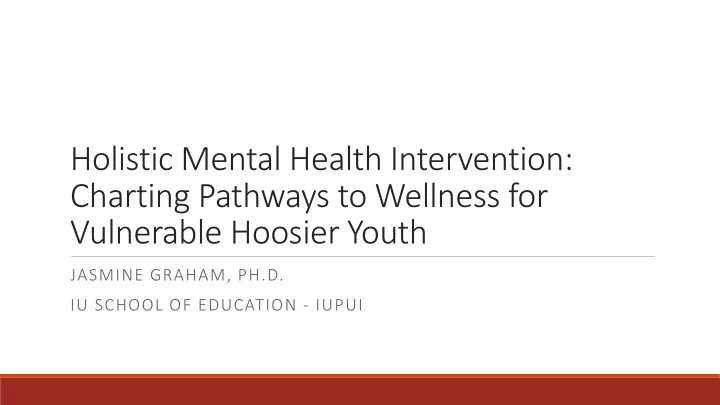

Holistic Mental Health Intervention: Charting Pathways to Wellness for Vulnerable Hoosier Youth JASMINE GRAHAM, PH.D. IU SCHOOL OF EDUCATION - IUPUI
Agenda • Assessment • Intersectional Considerations • Holistic Coping • Helper/Healer Relationship • Systemic Intervention • Family Survivors of Suicid e JASMINE GRAHAM, PHD. IU SCHOOL OF EDUCATION-IUPUI
Assessment In general, assessment seeks to determine: ◦ Level of suicidal intent ◦ Plans ◦ Availability of means • Suicidality is not a dichotomized phenomenon. • Assessment does not determine rationale for intervention. • Assessment does determines scale and scope of intervention. JASMINE GRAHAM, PHD. IU SCHOOL OF EDUCATION-IUPUI
Intersectional Considerations Identity markers: ◦ Age ◦ Geography ◦ Socioeconomic Status ◦ Race ◦ Ethnicity ◦ Sexuality and Orientation ◦ Presence of Disability ◦ etc JASMINE GRAHAM, PHD. IU SCHOOL OF EDUCATION-IUPUI
Intersectional Considerations SES Youth's Community Rural Urban JASMINE GRAHAM, PHD. IU SCHOOL OF EDUCATION-IUPUI
Rural and Urban Communities Each has its own unique strengths and assets Particular risks: ◦ Lack of access to diverse mental healthcare ◦ Group thinking re: help-seeking, wellness, and mental health ◦ Immobility (economically and socially) The result: limited access to healthy coping and holistic care JASMINE GRAHAM, PHD. IU SCHOOL OF EDUCATION-IUPUI
Holistic Coping Holistic Coping is a wellness model that considers psychological, social, emotional, and spiritual aspects of the youth’s identity as well as concrete identity markers previously identified. Holistic practices may include: ◦ Yoga ◦ Meditation ◦ Spirituality ◦ Social development ◦ Experiential practices These are provided in addition to talk therapy, medication management, and other traditional interventions. JASMINE GRAHAM, PHD. IU SCHOOL OF EDUCATION-IUPUI
Holistic Coping Competent Helpers and Healers: ◦ Consider Context ◦ Create Space Examples of Creating Space: ◦ 1. Therapist starts and ends each counseling session with guided meditation. ◦ 2. Pediatric practice provides yoga classes in-office ◦ 3. Case Manager starts a wellness book study with youth client JASMINE GRAHAM, PHD. IU SCHOOL OF EDUCATION-IUPUI
Helper/Healer Relationship Relationship is prime. Nobody cares how much you know, until they know how much you care. – Theodore Roosevelt Causality dilemma: ◦ Which came first: the chicken or the egg? Graduate student version: ◦ Which comes first: the relationship or the intervention? JASMINE GRAHAM, PHD. IU SCHOOL OF EDUCATION-IUPUI
Systemic Intervention Family Systems Theory: Individuals cannot be understood in isolation from one another, but rather as a part of their family unit. Homeostasis in the family system: The tendency of relationships to preserve the organizing principles of its existence. JASMINE GRAHAM, PHD. IU SCHOOL OF EDUCATION-IUPUI
Change in the Family System • 1 st Order Change: Change occurs on the behavioral level only. • 2 nd Order Change: Change occurs in the rules and norms governing the family structure, internal order, and beliefs. _____________ o 1 st Order Change creates a temporary shift that charts sustainable 2 nd Order Change. o Both types of change are important. JASMINE GRAHAM, PHD. IU SCHOOL OF EDUCATION-IUPUI
Interventions Informed by 1 st Order Interventions Informed by 2 nd Order Change Change Family therapy to provide clinical Family therapy to create cohesive updates on the Identified Patient. relationships that mutually support all members’ wellness. Suicidal behavior replacement Explore belief patterns that contribute to harmful behavior and develop an evolving epistemology that contributes to wellness goals. Remove dangerous items and weapons. Instead of embracing objects that harm, embrace objects that heal (ex. Soft lovies, healing photos, etc). Tracking: Maintain a log of suicidal Create a record (ex. log, photo album, thoughts, feelings, and behaviors. poetry journal, sketchbook, etc.) of wellness inspirations. JASMINE GRAHAM, PHD. IU SCHOOL OF EDUCATION-IUPUI
Family Survivors of Suicide Bereavement is complicated by: 1. Traumatic aftermath ◦ Increased risk for Post-Traumatic Stress Disorder (PTSD) 2. Stigma and shame 3. Mixed emotions 4. Need for reason/closure 5. Risk for survivors ◦ Increased risk for suicidality JASMINE GRAHAM, PHD. IU SCHOOL OF EDUCATION-IUPUI
Online Resources Useful Counseling Interventions: Online Resources: ◦ Individual Counseling American Association of Suicidology ◦ Family Therapy www.suicidology.org ◦ Group Therapy American Foundation for Suicide Prevention ◦ Online Support Groups www.afsp.org Alliance of Hope http://www.allianceofhope.org SOLOS - Survivors of Loved Ones to Suicide http://www.solossurvivorsoflovedonestosuicid e.com/online-groups.html JASMINE GRAHAM, PHD. IU SCHOOL OF EDUCATION-IUPUI
Jasmine Graham, Ph.D. Clinical Assistant Professor Program Coordinator Interim Faculty Director of Field Experience Counseling and Counselor Education IU School of Education – IUPUI grahamjj@iupui.edu JASMINE GRAHAM, PHD. IU SCHOOL OF EDUCATION-IUPUI
Recommend
More recommend